
د. احمد عبدهللا طفيليات
4
\
4
\
8102
( عدد االوراق
5
) م
\
3
\
موصل
lec:8
Scabies
Scabies is a contagious skin condition caused by tiny mites that burrow
into the skin.
Scabies mites
• Sarcoptes scabiei var. hominis is the human itch mite.
• Other species of scabies mites may cause infestations in other
mammals, such as domestic cats, dogs, pigs, and horses.
• It should be noted that species of mites found on other animals
might cause a self-limited infestation in humans with temporary
itching due to dermatitis; however they do not multiply on the
human host.
Morphology:
• Sarcoptes scabiei undergoes four stages in its life cycle: egg, larva,
nymph and adult.
• Adults : Mites are creamy in colour. The mature female mites
range in size from 0.3 – 0.5mm long,
and male mites are considerably smaller at approximately 0.25mm long.
Adults have 4 pairs of legs.
• Both males and females have sucker like appendages on the base
of the foot used for walking.
• Eggs are oval and 0.10 to 0.15 mm in length.
• Larvae similar to the adults but smaller and have 3 pairs of legs.
• Nymphs are similar to adults with 4 pairs of legs but smaller in
size.
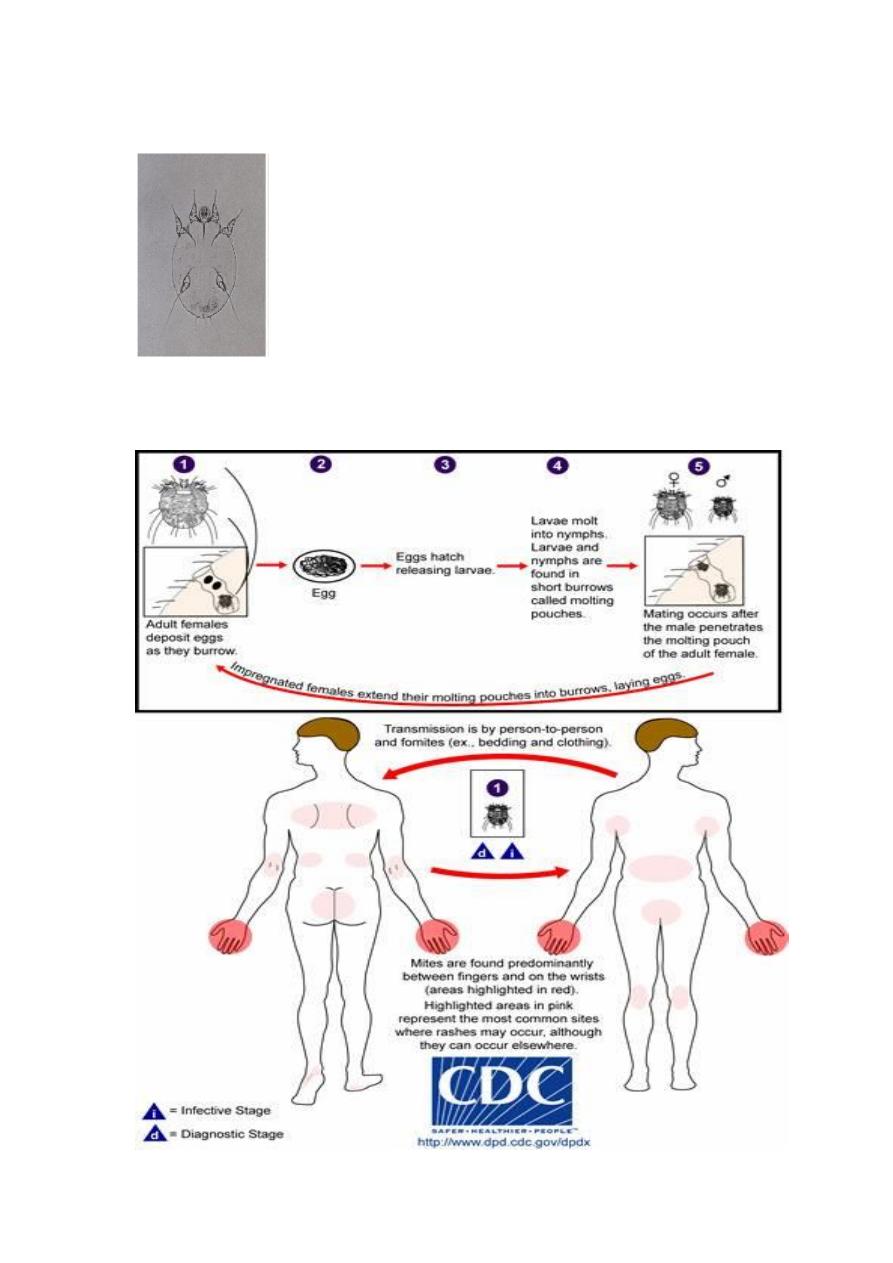
Sarcoptes scabiei adult
Sarcoptes scabiei larva
Life cycle

Life cycle:
• Mating occurs after the active male penetrates the molting pouch of
the adult female.
• Mating takes place only once and the female fertile for the rest of
its life. After mating, the male mite dies and the female begins to
lay eggs.
• Impregnated females (the usual infective parasite, however the
other stages can also be infective( both females and males are
required together)leave their molting pouches and wander on the
surface of the skin until they find a suitable site for a permanent
burrow or stays in the same molting pouch and deepens them .
• While on the skin’s surface, mites hold onto the skin using sucker-
like pulvilli attached to the two most anterior pairs of legs.
• When the impregnated female mite finds a suitable location, it
begins to make its characteristic serpentine burrow, laying eggs
in.
• After the impregnated female burrows into the skin, it remains
there and continues to lengthen its burrow and lay eggs for the rest
of its life (1-2 months).
• Females deposit 2-3 eggs per day as they burrow under the skin,
and hatch in 3 to 4 days.
• Under the most favorable conditions, about 10% of her eggs
eventually give rise to adult mites.
• After the eggs hatch, the larvae migrate to the skin surface and
burrow into the intact stratum corneum to construct almost
invisible, short burrows called molting pouches.
• After 3-4 days the larvae molt, the resulting nymphs have 4 pairs of
legs.
• These nymphs’ molts into slightly larger nymphs before molting
into adults.
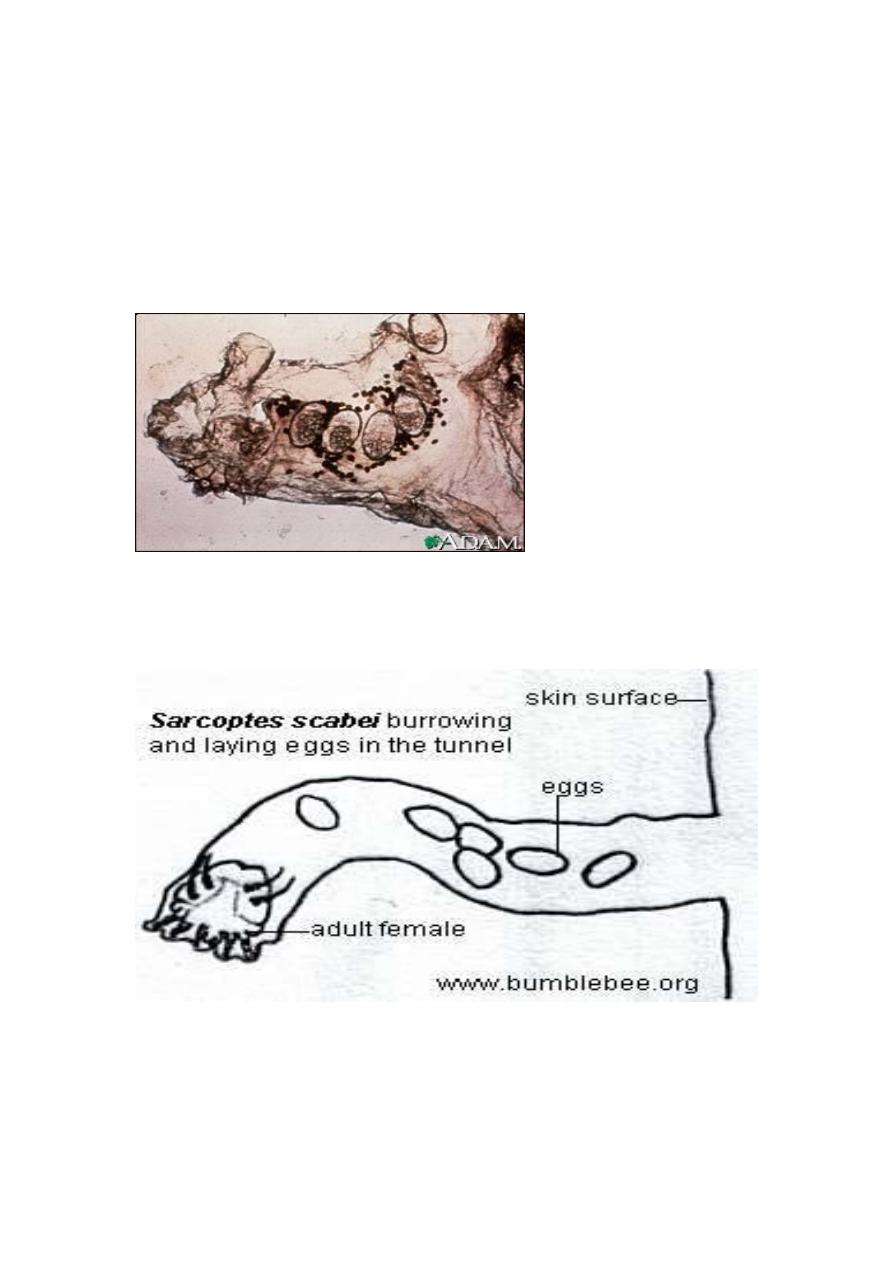
• Larvae mature into adults after 10 to 15 days from hatching.
• Larvae and nymphs may often be found in molting pouches or in
hair follicles and look similar to adults, only smaller.
• Without effective treatment, the life cycle of the scabies mite can
continue indefinitely
Photomicrograph of a skin scraping that contains a scabies mite, eggs,
and feces.
Sarcoptes scabei tunnel
How scabies spreads( transmission):
• Scabies usually spreads through prolonged periods of skin-to-skin
contact with an infected person, or through sexual contact.

• It is also possible but rare for scabies to be passed on by sharing
clothing, towels and bedding with someone who's infected (time
dependent method).
• Scabies mites usually can survive outside the human body for 24 to
36 hours, and may be extended up to 72 hours making infection by
coming into contact with contaminated clothes, towels or bed linen
a possibility time dependent.
• Scabies infestations can spread quickly because people are usually
unaware that they have the the infection until two to three weeks
after the initial infection.
• There's an increased risk of catching scabies in confined
environments, such as schools and nursing homes, where people
are in close proximity to one another.
• The incubation period required for the symptoms of scabies appear
after the initial infection is up to eight weeks( mostly 2-3 wk
s) during which the patient is contagious.
Scabies outbreaks
Scabies is widespread in densely populated areas with limited access to
medical care, and is most common in the following tropical and
subtropical areas:
• Africa
• Central and South America
• Northern and central Australia
• Caribbean Islands
• India
• Southeast Asia
• It is very common in Iraq, however there is no clear data about the
number of cases in our country.
• Scabies outbreaks can sometimes occur in overcrowded areas .
• Most outbreaks of scabies occur in the winter.

• Risk factors to get infection with scabies
• Extremes of age
• Presence of many children in the household
• Illiteracy
• Low family income
• Poor housing
• Long term sharing clothes and towels
• Irregular use of shower
Pathology, clinical picture and complications
• The mites burrow into the upper layer of the skin but never below
the stratum corneum.
• The burrows appear as tiny raised serpentine lines that are grayish
or skin-colored and can be a centimeter or more in length.
• Scabies like warm places, such as skin folds, between the fingers,
under fingernails, or around the buttock or breast creases. They can
also hide under watchstraps, bracelets or rings.
Clinical picture:
• Scabies is an intensely pruritic skin infestation. Approximately 300
million cases of scabies are reported worldwide each year.
• Burrows are the pathognomonic sign of the infestation. They
appear as serpiginous, grayish, threadlike elevations in the
superficial epidermis, ranging from 2-10 mm long.
• High-yield locations for burrows include the following:
• Webbed spaces of fingers, flexor surfaces of the wrists, elbows,
axillae, belt line, feet, scrotum in males and areolae in females.

Complications of scabies
Secondary infection
Bacterial infection due to itching and scratch.
Scabies has been known to worsen some pre-existing skin
conditions, such as eczema .
Crusted scabies:
• Crusted scabies, also known as Norwegian scabies, is the most
severe form of scabies where thousands or even millions of scabies
mites are present.
• The condition affects all parts of the body, including head, neck,
nails and scalp.
• Unlike normal scabies, the rash associated with crusted scabies
usually doesn't itch.
• In crusted scabies, the increase in the number of mites causes thick
warty crusts on the skin. It's often mistaken for psoriasis (a skin
condition that causes red, flaky, crusty patches of skin covered
with silvery scales).
• Crusted scabies affects people with a weakened immune system as
the very young children, elderly people, those on steroid therapy or
chemotherapy, patients with AIDS, bone marrow aplasia, pregnant
women, and diabetic patients.
• Healthy immune system appears to interrupt the reproductive cycle
of the mites. For example, most people with scabies will only have
5 to 15 mites on their body at any time. But if the immune system
is weakened, the number of scabies mites can increase
significantly.
• People with crusted scabies can have thousands or millions of
scabies mites on their body at any one time.
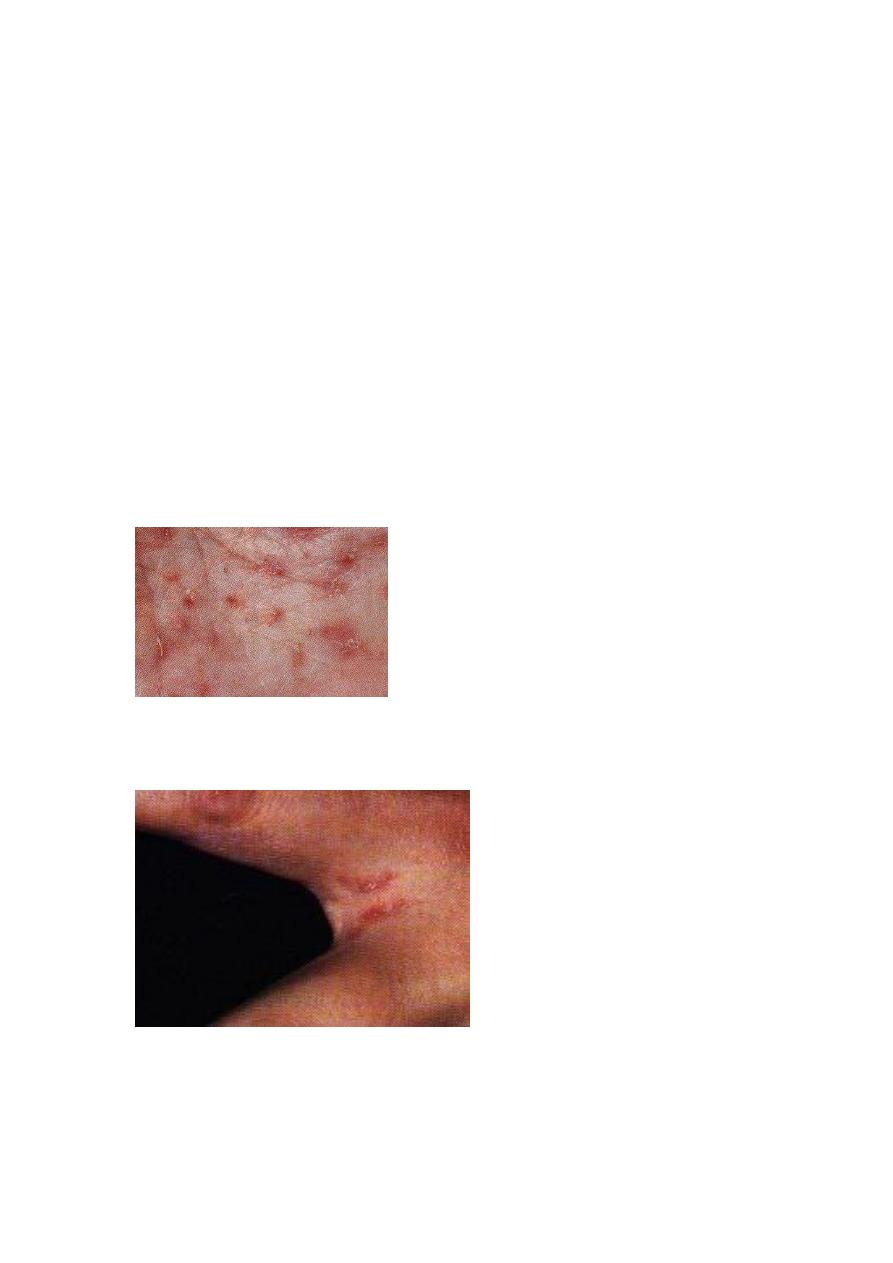
• Because of the high number of scabies mites, crusted scabies is
highly contagious. Even minimal physical contact with a person
with crusted scabies, or with their beddings or clothes, can lead to
infection.
• Contact with someone with crusted scabies will only lead to the
normal type of scabies in people with a healthy immune system.
Nodular scabies
Nodules occur in 7-10% of patients with scabies, particularly young
children.
In neonates unable to scratch, pinkish brown nodules ranging in size
from 2-20 mm in diameter may develop.
Scabies rash on the hand. Burrows visible.
Scabies burrows between fingers.
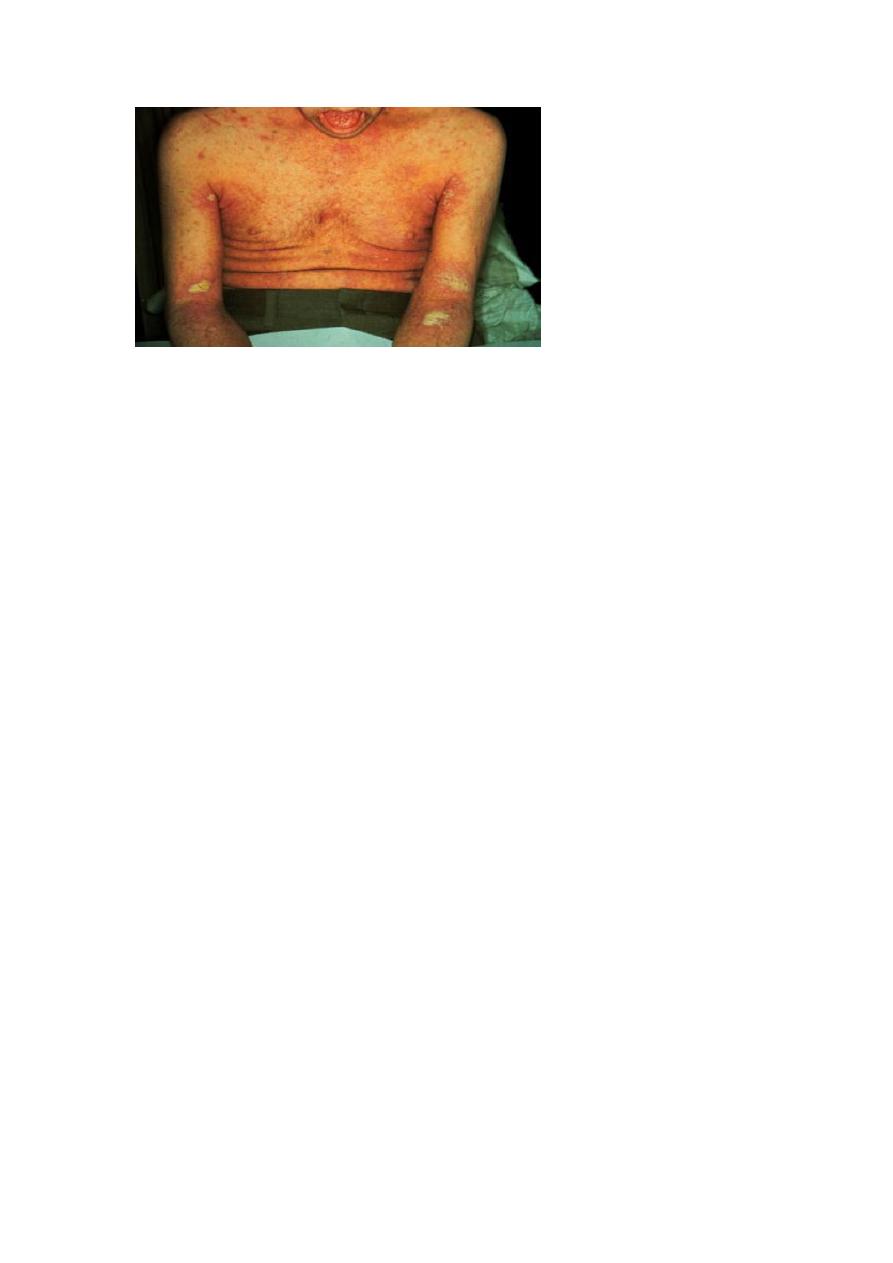
Crusted scabies
Diagnosis
• Diagnosis of a scabies infestation usually is based upon the
appearance and distribution of the rash and the presence of
burrows.
• Whenever possible, the diagnosis of scabies should be confirmed
by identifying the mite or mite eggs or fecal matter (scybala).
• This can be done by carefully removing the mite from the end of its
burrow using the tip of a needle or by obtaining a skin scraping to
examine under a microscope for mites, eggs, or mite fecal matter
(scybala).
• However, a person can still be infested even if mites, eggs, or fecal
matter cannot be found; fewer then 10-15 mites may be present on
an infested person who is otherwise healthy.
Treatment of scabies
• It's not usually a serious condition, but it does need to be treated.
• Scabies treatment includes administration of a scabicidal agents
(eg, permethrin, malathion, or ivermectin), as well as an
appropriate antimicrobial agent if a secondary infection has
developed.
• Pruritus may be partially alleviated with an oral antihistamine.

• Permethrin 5% cream is usually recommended as the first choice
treatment. Malathion 0.5% lotion is used if permethrin is
ineffective.
• Crusted scabies is treated by ivermectin. Ivermectin kills the mites
by blocking their nervous system activity.
Prevention
• Scabies is prevented by avoiding direct skin-to-skin contact with an
infested person or with items such as clothing or bedding used by
an infested person.
• Scabies treatment is recommended for members of the same
household.
• Bedding and clothing worn or used next to the skin anytime during
the 3 days before treatment should be machine-washed and dried
using the hot water and hot dryer cycles or be dry-cleaned.
• Storing in a closed plastic bag for several days to a week can
disinfest items that cannot be dry-cleaned or laundered. Scabies
mites generally do not survive more than 3 days away from human
skin.
• Children and adults usually can return to childcare, school, or
work, one day after starting treatment.
• Persons with crusted scabies and their close contacts, including
household members, should be treated rapidly and aggressively to
avoid outbreaks.
• Rooms used by a patient with crusted scabies should be thoroughly
cleaned and vacuumed after use.
• Environmental disinfestation using pesticide sprays or fogs is
unnecessary and is discouraged.

د.احمد طفيليات
00
\
4
\
8102
( عدد االوراق
7
) م
\
3
\
موصل
lec:9
Human lice:
• Lice are parasitic insects that can be found on peoples
,
heads,
bodies and pubic areas.
• They live by feeding on human blood.
• There are three types of Human lice:
• Pediculus humanus capitis (head louse),
• Pediculus humanus corporis (body louse, clothes louse), and
• Pthirus pubis ("crab" louse, pubic louse).
• Only the body louse is known to spread disease (vector).
• Lice infestation is transmitted by close person-to-person contact.
• Pubic lice infestations (pthiriasis) are usually spread through sexual
contact.
• There is no animal mediator.
•

• Louse has three stages: egg, nymph, and adult.
• Eggs (Nits) : are lice eggs.
• They are hard to see and are often confused for dandruff or hair
spray droplets in case of head lice. Nits are laid by the adult female
and are attached at the base of the hair shaft nearest the scalp.
• Body lice live and lay eggs on clothing and only move to the skin
to feed.
• Pubic lice and their eggs typically are found attached to hair in the
pubic area but sometimes are found on coarse hair elsewhere on the
body (for example, eyebrows, eyelashes, beard, mustache, chest,
armpits, etc.).
• They are 0.8 mm by 0.3 mm, oval and usually yellow to white.
• Nits take about 1 week to hatch.
• Viable eggs are usually located within 6 mm of the scalp.
• Nymphs : The egg hatches to release a nymph. The nymph looks
like an adult louse, but is about the size of a pinhead. Nymphs
mature after three molts and become adults about 7 days after
hatching.
• Adults : The adult louse is about the size of a sesame seed, has 6
legs (each with claws), and is tan to grayish-white. With dark hair,
the adult louse will appear darker.
• Females are usually larger than males and can lay up to 8 nits per
day.
• Adult lice can live up to 30 days on a person’s head.
• To live, adult lice need to feed on blood several times daily.
• Without blood meals, the louse will die within 1 to 2 days outside
the host.
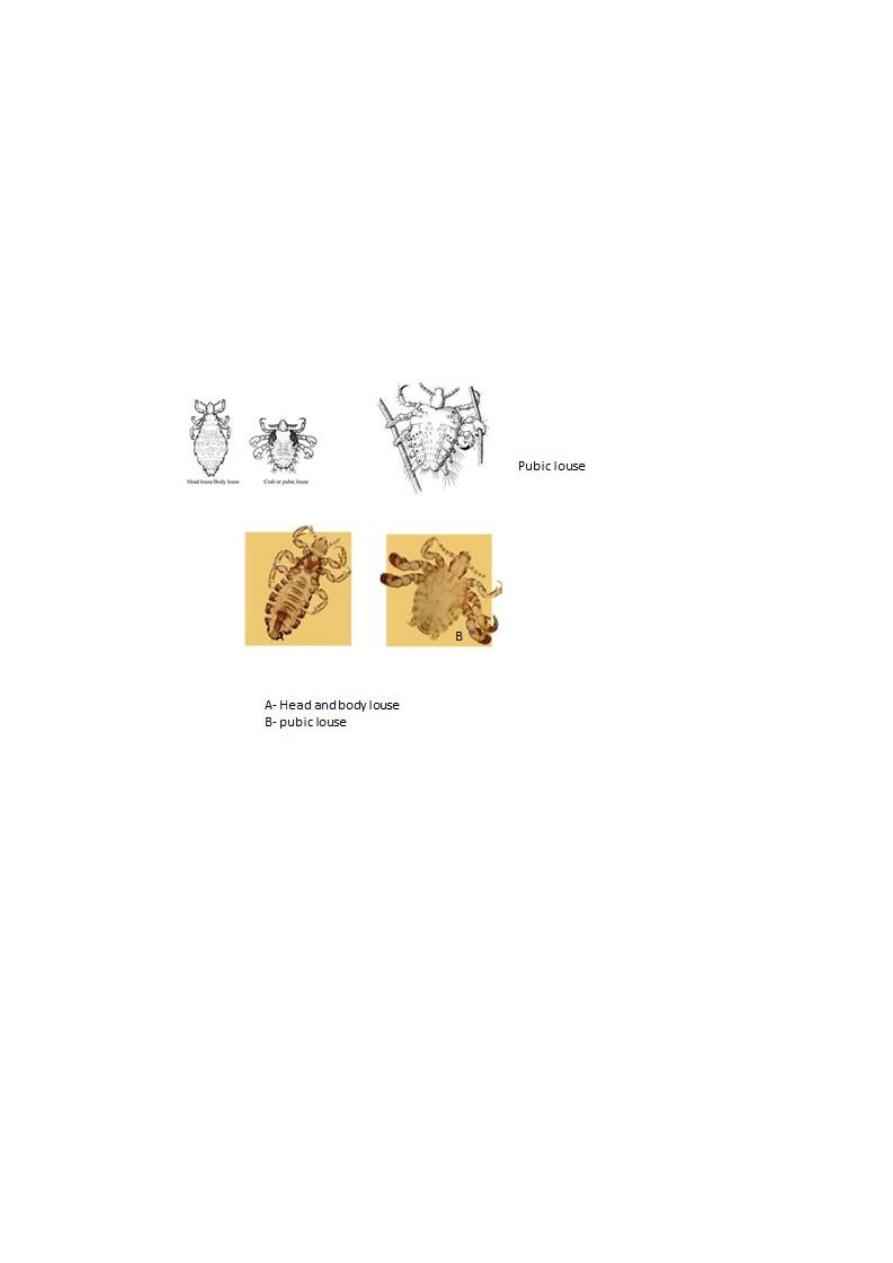
• Adult head lice are 2.1–3.3 mm in length. Adult body lice are 2.3–
3.6 mm in length. Adult pubic lice are very small (1.1-1.8 mm
long) and aren't easy to see.
• They're a yellow-grey or dusky red colour and have six legs.
• Pubic lice are sometimes known as crabs because they have two
large front legs that look like the claws of a crab. These are used to
hold onto the base of hairs.
Clinical picture:
• Head and body louse infestation-
• Head lice are not known to transmit any disease and therefore are
not considered a health hazard.
• Head lice and body lice infestation can be asymptomatic,
particularly with a first infestation or when an infestation is light.
• Itching ("pruritus") is the most common symptom of head lice
infestation and is caused by an allergic reaction to louse bites.
• It may take 4–6 weeks for itching to appear the first time a person
has lice.

• Other symptoms may include:
• A tickling feeling or a sensation of something moving in the hair;
• Irritability and sleeplessness; and Sores on the head and the body
caused by Scratching. These sores caused by scratching can
sometimes become infected with bacteria normally found on a
person’s skin.
Louse-borne diseases
• Louse-borne diseases are associated with a high prevalence of body
louse infestation. Head lice can carry pathogen but do not transmit
them.
• Body lice are vectors of bacterial diseases transmitted to humans,
including:
• Trench fever caused by Bartonella quintana
• Relapsing fever caused by Borrelia recurrentis ,
• Epidemic typhus caused by Rickettsi,
• Acinetobacter baumannii,
• Plague due to Yersinia pestis.
•
Pubic lice (Phthirus pubis):
• They are tiny parasitic insects that live on coarse human body hair,
such as pubic hair.
• As well as being found in pubic hair, the lice are also sometimes
found in:
• Underarm and leg hair
• Hair on the chest, abdomen and back
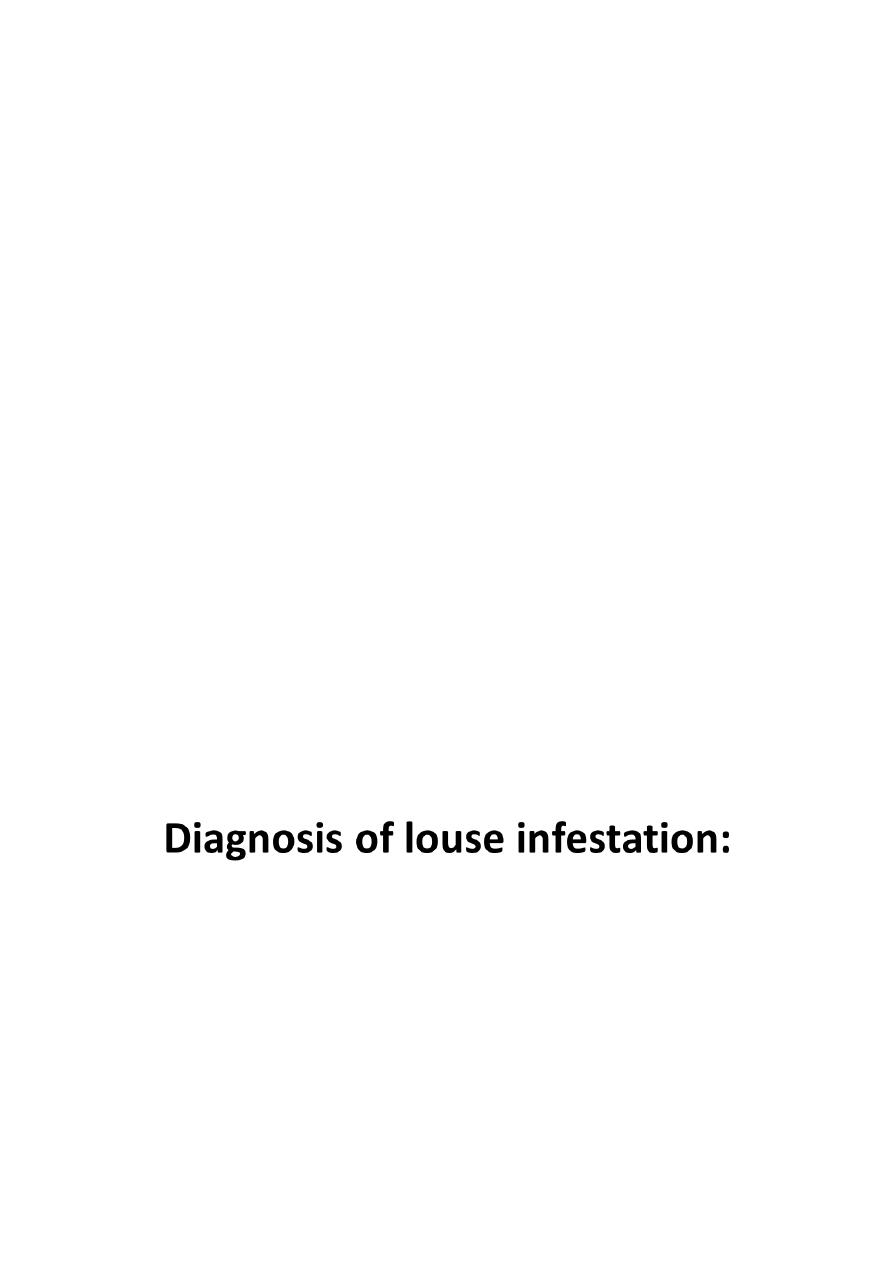
• Facial hair, such as beards and moustaches eyelashes and
eyebrows (very occasionally). Unlike head lice pubic lice don't live
in scalp hair.
• Pubic lice are spread through close bodily contact, most commonly
sexual contact.
• It's also possible but rare for pubic lice to be spread through
sharing clothes, towels and bedding.
Symptoms of pubic lice:
• After getting pubic lice, it can take several weeks before any
symptoms appear. Symptoms are the same for men and women and
include:
• Itching is the most common symptom of pubic lice and is an
allergic reaction to their saliva. The itching is usually worse at
night, when the lice are most active.
• Inflammation and irritation caused by scratching.
• Black powder in the under wears.
• Blue spots or small spots of blood on skin, such as on thighs or
lower abdomen (caused by lice bites).
• Diagnosis of lice is generally based on the presence of nits or lice.
• Lice may be seen on the scalp, in the hair, or on clothing of the
infected person.
• Direct visual examination (visual inspection).
• Plastic detection comb with magnifier is the best visual screening
for diagnosis of head louse infestation.
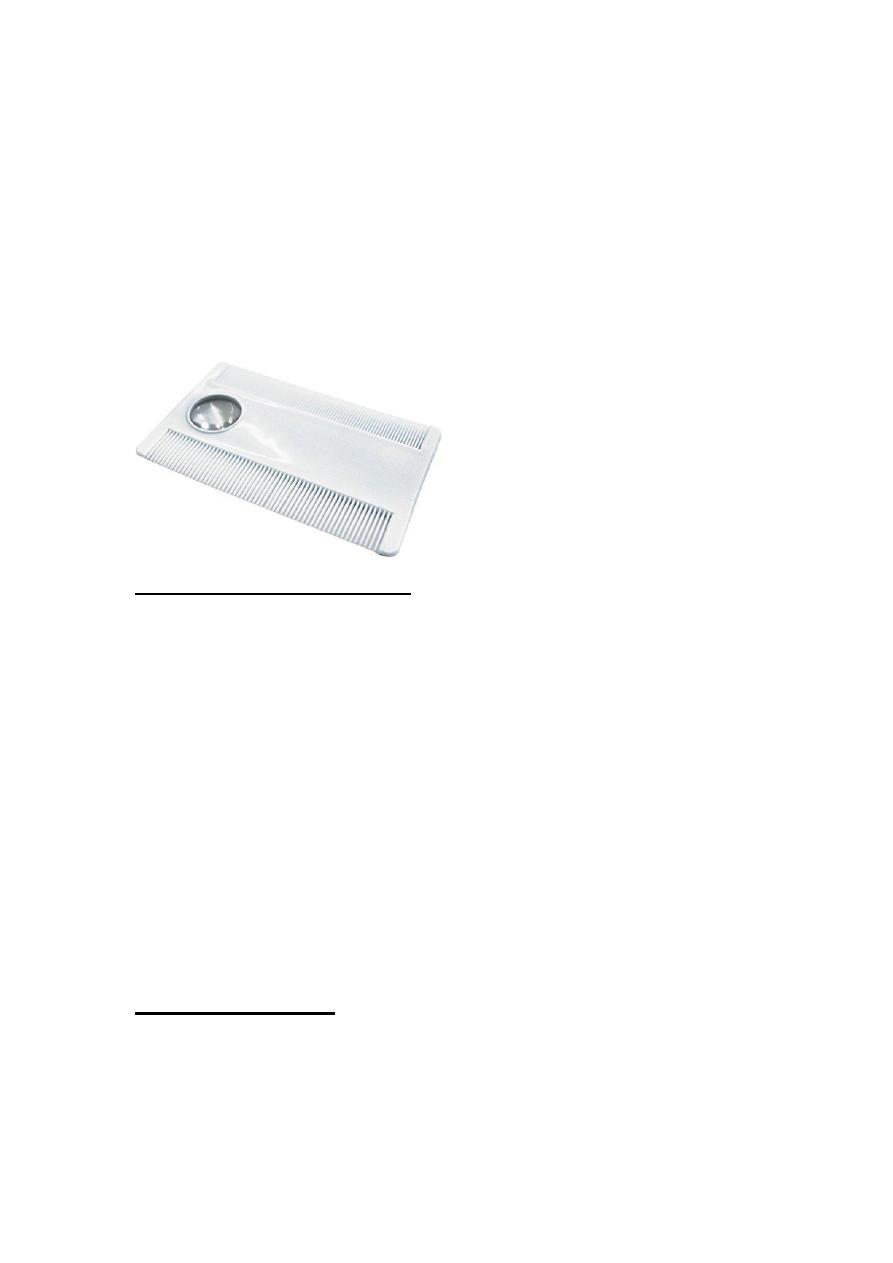
• Body louse infestation is detected by examination of the clothes of
the infested person as they usually only move to the skin to feed.
• Pubic lice are diagnosed by finding lice in the under wears or pubic
hair and patients should perform general screening for sexual
transmitted diseases.
Plastic detection comb for head lice
Treatment of louse infestation:
• Removing lice by hand or with a lice comb and shaving the scalp.
• Chemical Products. Cresol, naphthalene, sulfur, and petroleum, in
combination with oil or vinegar.
• Pediculicides e.g.: organochlorines (DDT, lindane),
organophosphates (malathion).
• Treating pubic lice: Pubic lice can be treated at home with
insecticide cream, lotion or shampoo. The whole body must be
treated, taking care to avoid the eye. The treatment usually needs to
be repeated after three to seven days. The medication should not be
used more than twice.
Preventing lice spread
• Adults and children who live with a person diagnosed with lice
should be examined for lice and treated if needed.
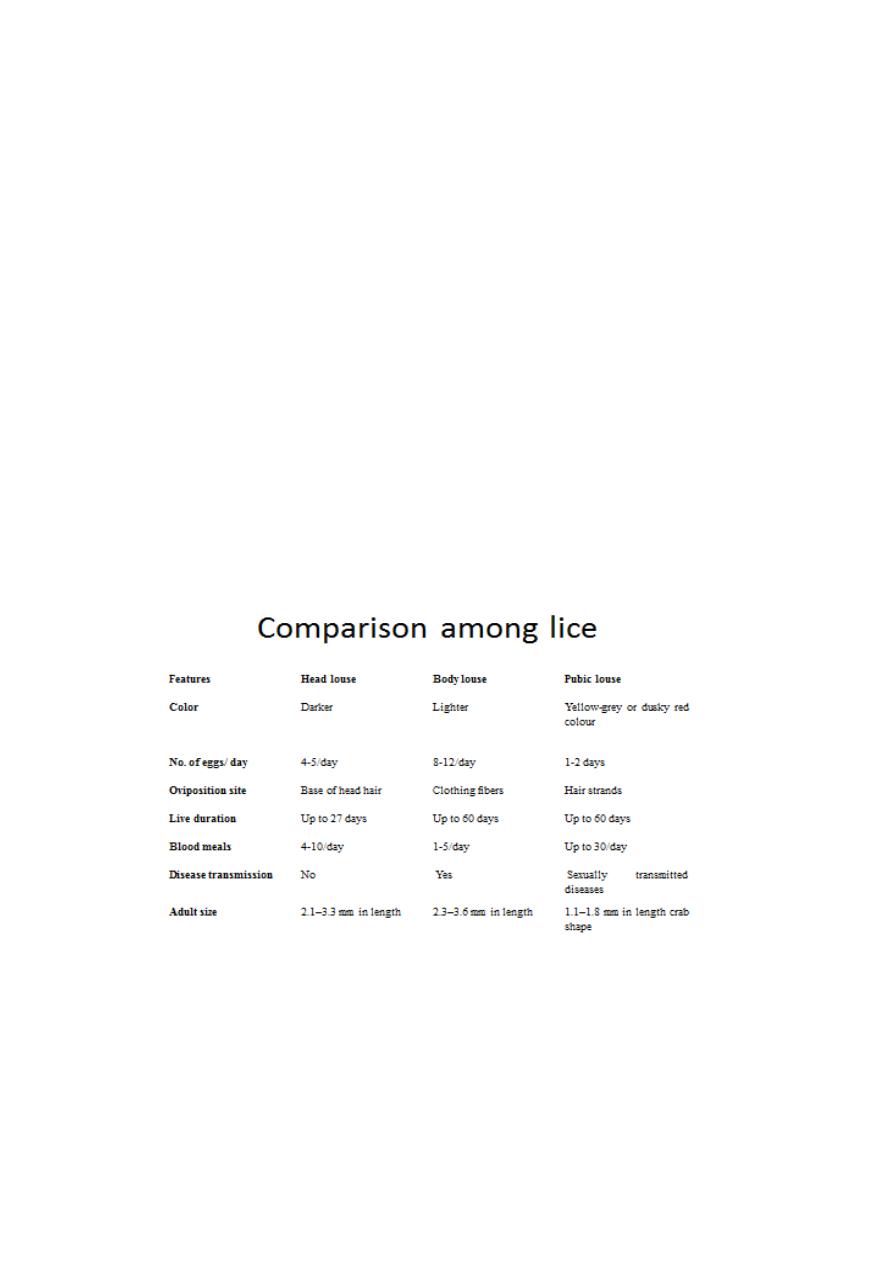
• Clothing, bedding, and towels used within 48 hours before
treatment should be washed in hot water and dried in an electric
dryer on the hot setting.
• Dry cleaning is also effective. Temperature is highly influential on
the louse’s physiology. Lice prefer a temperature between 29∘ and
32
∘C
• At 50∘C, body lice die, and this temperature is critical when
washing clothes, as water and soap alone will not kill lice.
• Items that the person used more than two days before treatment are
not likely to be infested because lice cannot survive off the body
for more than 48 hours.
• A vacuum clean for furniture, carpet, and car seats.
• Items that cannot be washed or vacuumed can be sealed inside a
plastic bag for two-three days.
Anopheles and Sandflies
• Anopheles Mosquitoes: Anopheles (Greek anofelís: "useless”)
• Malaria is transmitted among human beings by female mosquitoes
of the genus Anopheles.

• Female mosquitoes take blood meals to carry out egg production,
and such blood meals are the link between the human and the
mosquito hosts in the parasite life cycle.
• Mosquitoes prefer stagnant water within which they lay their eggs.
They most commonly infest ponds, marshes, swamps and other
wetland habitats.
• Hot, humid environments are most convenient to mosquito growth
and survival.
• Infestations can occur easily in tropical areas.
• Anophelines are found worldwide except Antarctica.
The successful development of the malaria parasite in the mosquito (from
the "gametocyte" stage to the "sporozoite" stage) depends on some
factors:
1. Ambient temperature and humidity .
2. Life span of the Anopheles whether it survives long enough to allow
the parasite to complete its cycle in the mosquito host ("sporogonic" or
"extrinsic" cycle, duration 10 to 18 days).
Life cycle and stages of Anopheles:
• Anophelines go through four stages in their life cycle:
egg, larva, pupa, and adult.
• The first three stages are aquatic and last 5-14 days.
• The adult females can live up to 12 weeks in nature.
Adults
• Like all mosquitoes, adult anophelines have slender bodies with 3
sections: head, thorax and abdomen.
• The head is specialized for acquiring sensory information and for
feeding.
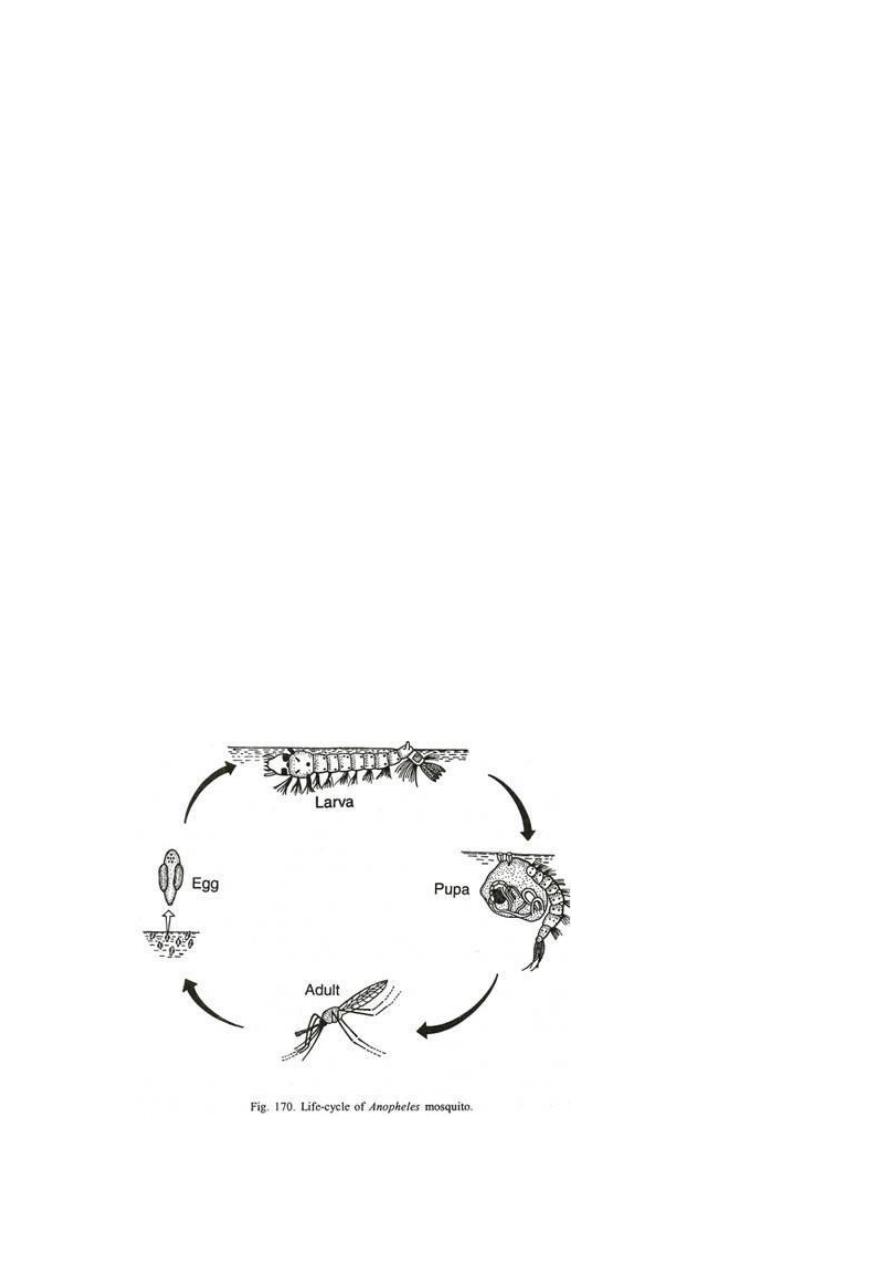
• The head contains the eyes and a pair of long, many-segmented
antennae.
• Hairy antennae in male (plumose) and less hairy in females
(pylose).
• The head also has an elongate, forward-projecting proboscis used
for feeding, and two sensory palps.
• Three pairs of legs and a pair of wings are attached to the thorax.
• *Anopheles mosquitoes can be distinguished from other
mosquitoes by the palps, which are as long as the proboscis, and by
the presence of discrete blocks of black and white scales on the
wings.
• *Adult Anopheles can also be identified by
• their typical resting position: males and females rest with their
abdomens sticking up in the air rather than parallel to the surface
on which they are resting.
• Males live for about a week, feeding on nectar and other sources of
sugar.
• Females will also feed on sugar sources for energy but usually
require a blood meal for the development of eggs.
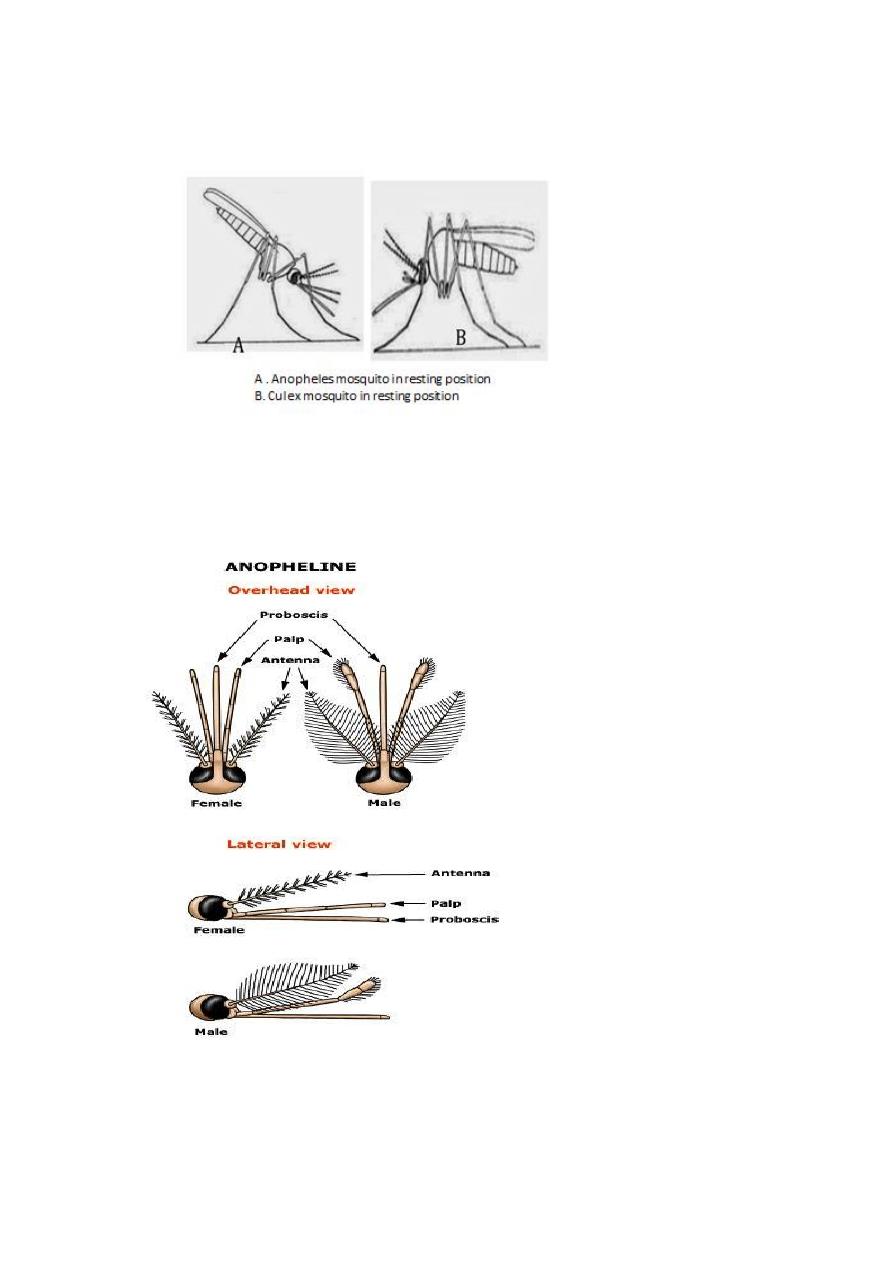
Morphology of the mouth parts of anopheles male and female

Mosquito Control Measures:
• 1- personal protection from mosquito bites can prevent blood meal
for these females to lay eggs in addition to the prevention of
transmission of infection to new person. This can be achieved by:
• Closure and screening of all the windows, doors and vents.
• Protection against mosquito bite by covering the body with clothes,
bed nets (insecticide treated) and mosquito repellent.
• Sprays of insecticides are used to instantly kill the adults on their
resting places such as walls. But most of such insecticides have
side effects on the human beings as well as the environment and
other life forms.
• 2- elimination of breeding places by:
• Preventing water logging, destroying unwanted water collections
and keeping the water containers closed.
• Further, different types of larvicides whether chemical
(insecticides) or biological (Guppy or Gambusia fish or bacteria or
fungi) can be used on such breeding grounds to kill the developing
larvae and pupae.
Sand fly (phlebotomus):
Diseases transmitted by the Sand fly are:
Kalazar
Baghdad boi
Sand fly fever
Morphology :
• 0.4mm x 0.12 mm
• Convex dorsally and concave ventrally.
• Dark yellow in colour
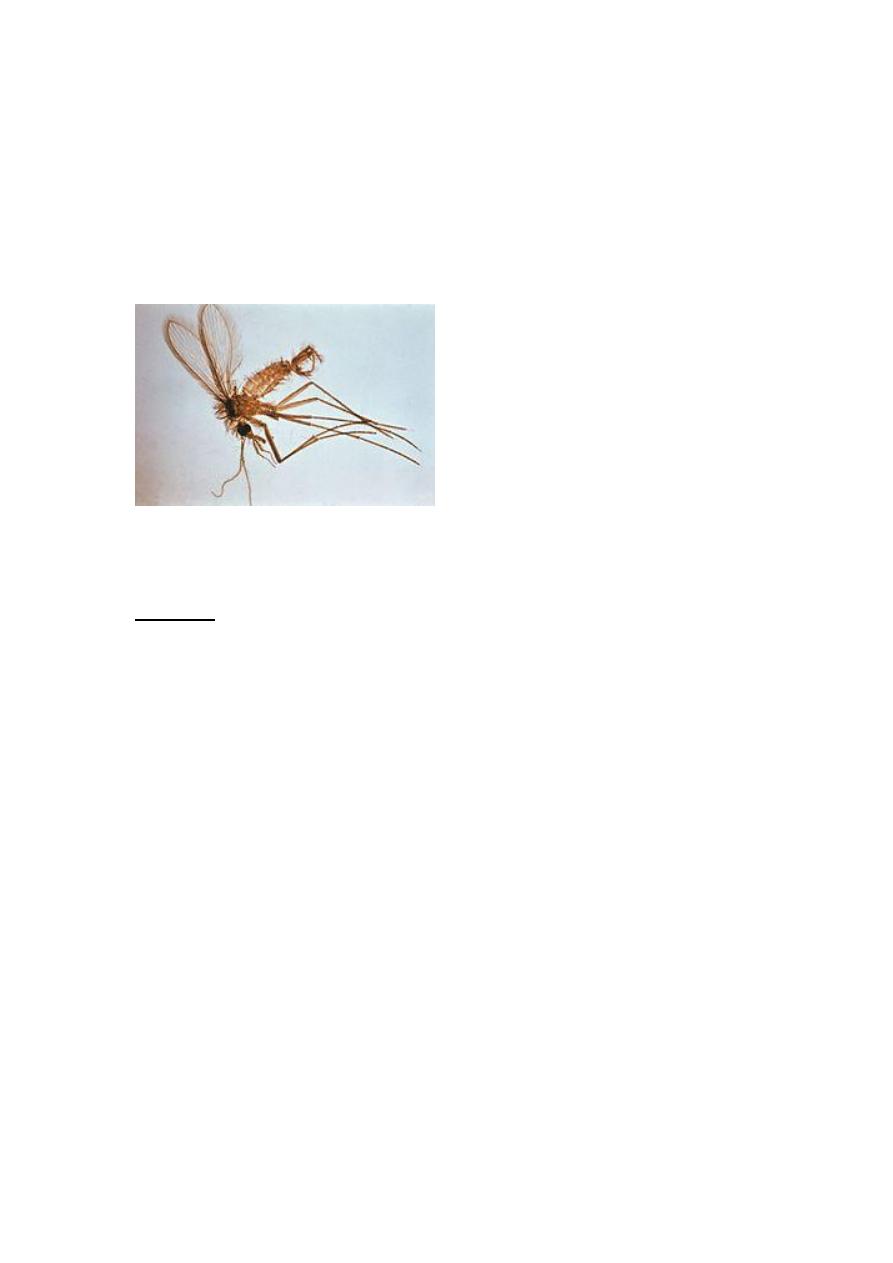
• The body segment has hairy spines
• Body is covered by profuse hair
• Wings are vertical downward
• Only female suck blood
Sand fly (phlebotomus):
Lifecycle
• Batches of thirty to seventy eggs are laid in cracks and holes in the
ground, in crevices in masonry and among leaf litter.
• The eggs require a humid environment to avoid desiccation, and
hatch into larvae within about twenty days.
• The larvae pass through four instars over the course of three to four
weeks, before selecting an upright position and become pupae.
• Adults emerge from the pupae after about one to two weeks.
• The whole cycle takes thirty to sixty days unless the larvae
diapause, when it may take four or five months.
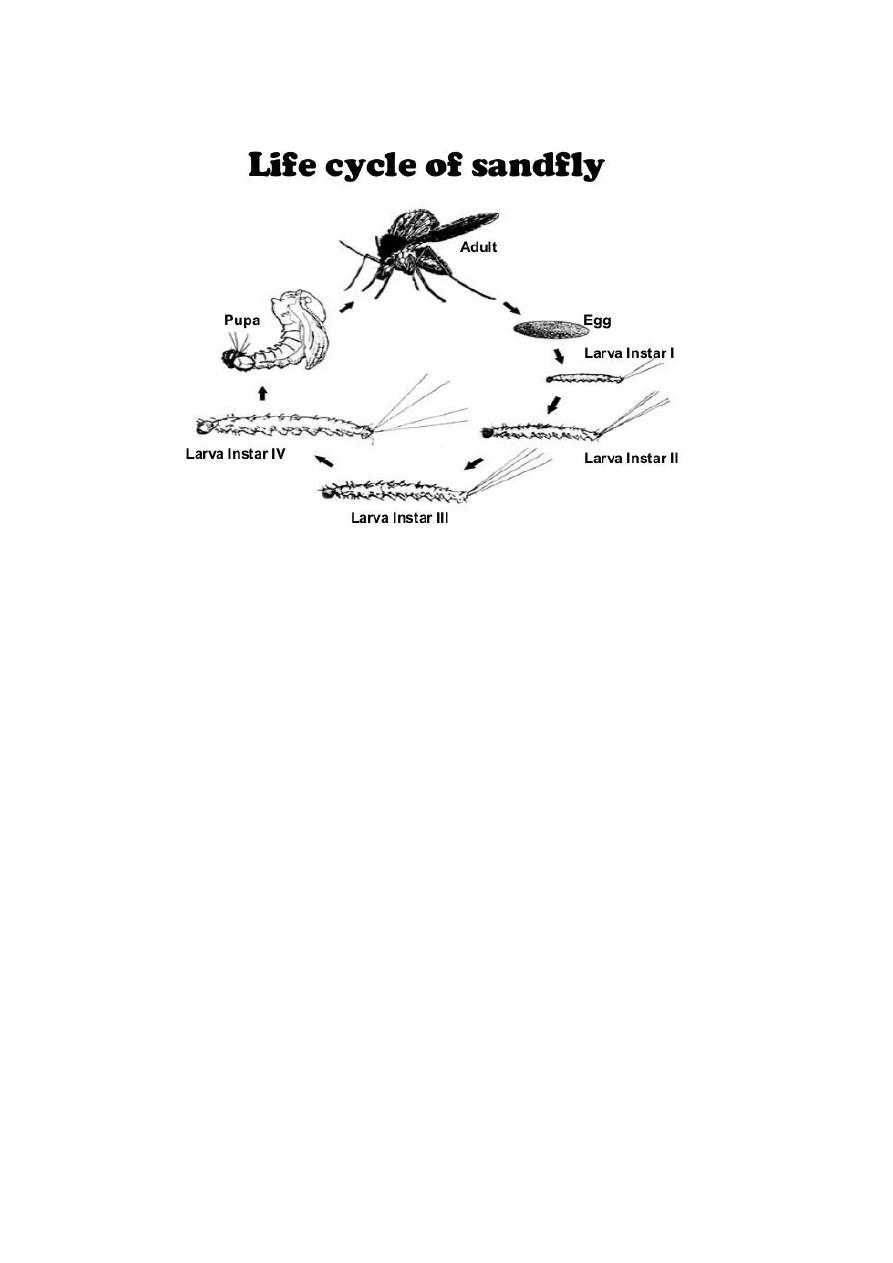
Life cycle of sandfly.
Control measures of the sand flies
• Removal of cattles and poultry from living houses
• Cracks cervices to be sealed
• Sulphure fumigation, formalin cresol or DDT spray
• Repellents like dimethyl phthalate
• Sleep under sand fly net (45 mesh/inch)
